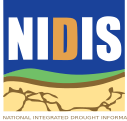Earth:National Integrated Drought Information System
The National Integrated Drought Information System (NIDIS) Act was signed into law in 2006 (Public Law 109-430). The Western Governors' Association described the need for NIDIS in a 2004 report, Creating a Drought Early Warning System for the 21st Century: The National Integrated Drought Information System.[1] The NIDIS Act calls for an interagency, multi-partner approach to drought monitoring, forecasting, and early warning, led by the National Oceanic and Atmospheric Administration (NOAA).[2]
NIDIS is being developed to consolidate data on drought’s physical, hydrological, and socio-economic impacts on an ongoing basis, to develop drought decision support and simulation tools for critical, drought-sensitive areas, and to enable proactive planning by those affected by drought.
NIDIS draws on the personnel, experience, and networks of the National Drought Mitigation Center, the NOAA Regional Climate Centers, and the Regional Integrated Sciences and Assessments (RISAs), among others. Federal agencies and departments partnering in NIDIS include the U.S. Army Corps of Engineers, the Bureau of Reclamation, the U.S. Geological Survey, NASA, the U.S. Department of Energy, the U.S. Environmental Protection Agency, the National Science Foundation, and the Natural Resources Conservation Service.[3]
NIDIS is building on existing system infrastructure, data, and operational products from various agencies. For example, it incorporates data from the SNOTEL (SNOw TELemetry) network of the U.S. Department of Agriculture’s Natural Resources Conservation Service, reservoir and streamflow levels from the U.S. Department of the Interior and the U.S. Army Corps of Engineers, and river forecasts from the National Weather Service. It incorporates operational products such as the U.S. Drought Monitor and the Seasonal Drought Outlook. Researchers are working to help decision-makers in many contexts by making drought monitoring, forecasting, and impacts information available at a variety of spatial scales and geopolitical boundaries, including regional, watershed, county and tribal. NIDIS is a prototype for information services, in support of preparing for and adapting to climate variation and change. In late 2007, NIDIS launched the U.S. Drought Portal, or drought.gov, a website that pulls together many federal, state, and academic resources for monitoring drought.[4][5]
The NIDIS Program is supported by the NOAA Climate Program Office and is housed at the NOAA Earth System Research Laboratory in Boulder, Colorado.
Related legislation
- Drought Information Act of 2013 (S. 376; 113th Congress) - a bill that would authorize funding for the National Integrated Drought Information System (NIDIS) through 2018.[6] The bill passed in the United States Senate during the 113th United States Congress.[7]
- National Integrated Drought Information System Reauthorization Act of 2013 (H.R. 2431; 113th Congress) - a bill that would authorize funding for the National Integrated Drought Information System through 2018.[8][9] The bill was scheduled for a vote on the House floor.
- An Act to Reauthorize the National Integrated Drought Information System (P.L. 113-86, 128 STAT. 1015)
Notes
- ↑ Creating a Drought Early Warning System for the 21st Century: The National Integrated Drought Information System, "Archived copy". Archived from the original on 2013-02-18. https://web.archive.org/web/20130218191612/http://www.westgov.org/wga/publicat/nidis.pdf. Retrieved 2014-02-07.
- ↑ “Activities and Plans of the National Integrated Drought Information System” http://conference.ifas.ufl.edu/CIMR/abstracts/Plenary%20Session%20Speaker%20Abstracts/Verdin.pdf
- ↑ NIDIS Implementation Plan, p. 23, http://www.drought.gov/pdf/NIDIS-IPFinal-June07.pdf
- ↑ Showstack, Randy (November 13, 2007). "New U.S. drought web site". Eos, Transactions American Geophysical Union 88 (46): 487. doi:10.1029/2007EO460005. http://onlinelibrary.wiley.com/doi/10.1029/2007EO460005/abstract. Retrieved August 12, 2014.
- ↑ "U.S. Drought Policy – NIDIS". http://drought.unl.edu/planning/uspolicy.aspx#NIDIS. Retrieved August 12, 2014.
- ↑ Cox, Ramsey (3 February 2014). "Senate passes bill funding drought information program". The Hill. http://thehill.com/blogs/floor-action/senate/197331-senate-passes-bill-funding-drought-information-program. Retrieved 7 February 2014.
- ↑ "S. 376 - All Actions". United States Congress. http://beta.congress.gov/bill/113th-congress/senate-bill/376/all-actions/. Retrieved 7 February 2014.
- ↑ "H.R. 2431 - Summary". United States Congress. http://beta.congress.gov/bill/113th/house-bill/2431. Retrieved 7 February 2014.
- ↑ Snider, Annie (30 September 2013). "Drought: House Science Subpanel to Consider Reauthorizing Coordination Program". National Water Resources Association. Archived from the original on 10 February 2014. https://archive.is/20140210160134/http://www.nwra.org/content/articles/drought-house-science-subpanel-to-consider-reautho/. Retrieved 10 February 2014.
External links


